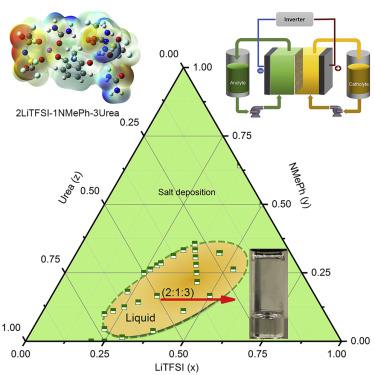Chem ( IF 23.5 ) Pub Date : 2018-09-20 , DOI: 10.1016/j.chempr.2018.08.024 Changkun Zhang , Zhihui Niu , Yu Ding , Leyuan Zhang , Yangen Zhou , Xuelin Guo , Xiaohong Zhang , Yu Zhao , Guihua Yu

|
Recent development of high-energy-density organic-based redox flow batteries for large-scale energy storage systems is challenged by the stability and limited molar concentration of the redox-active molecules. Here, we report green and effective eutectic-based anolytes to achieve enhanced reversibility and high concentration through phthalimide derivatives. A nearly 6-fold increase in solubility can be achieved with the eutectic electrolytes composed of phthalimide derivatives, urea, and lithium bis(trifluoromethanesulfonyl)imide (LiTFSI). The interaction between phthalimide derivatives and LiTFSI weakens the chemical bonds, facilitating the formation of eutectic electrolytes. Meanwhile, urea contributes to decreasing the viscosity of the eutectic solvent as well as to improving the reversibility of phthalimide radical anions generated during the electrochemical process. Compared with previously reported organic redox flow batteries, the resulting redox flow battery demonstrates comparable storage capacity but superior cycling stability, showing the promise of the eutectic-phthalimide-based organic molecules for high-performance organic redox flow batteries.
中文翻译:

高浓度邻苯二甲酰亚胺基阳极电解液,用于可逆性增强的有机氧化还原液流电池
用于大规模能量存储系统的高能量密度有机基氧化还原液流电池的最新发展受到氧化还原活性分子的稳定性和有限的摩尔浓度的挑战。在这里,我们报告了绿色和有效的基于共晶的阳极电解液,可通过邻苯二甲酰亚胺衍生物实现增强的可逆性和高浓度。由邻苯二甲酰亚胺衍生物,尿素和双(三氟甲磺酰基)酰亚胺锂(LiTFSI)组成的共晶电解质可实现近6倍的溶解度增加。邻苯二甲酰亚胺衍生物和LiTFSI之间的相互作用削弱了化学键,促进了共晶电解质的形成。同时,尿素有助于降低低共熔溶剂的粘度以及改善电化学过程中产生的邻苯二甲酰亚胺自由基阴离子的可逆性。与以前报道的有机氧化还原液流电池相比,所得的氧化还原液流电池具有可比的存储容量,但循环稳定性出色,这表明基于共晶邻苯二甲酰亚胺的有机分子有望用于高性能有机氧化还原液流电池。


























 京公网安备 11010802027423号
京公网安备 11010802027423号